The Global Partnership for Education’s Evolving Support to Fragile and Conflict-Affected States
Summary
This article traces the history of policy development at the Global Partnership for Education (GPE) between 2003 and 2015 in order to understand its increasing support of education in fragile and conflict-affected states. It looks at three country case studies—Liberia, Madagascar, and the Democratic Republic of Congo—to demonstrate the complexity of funding in these settings and how global financing policies shift through implementation in different country contexts.
A version of these findings is also available on NORRAG’s website.
Key Takeaways
We offer the following practical steps and actions based on this research below (click to expand).
+ For Policymakers
| INSIGHTS | ACTIONS | |
|---|---|---|
| In order to achieve education for all, mechanisms must be put in place to finance countries experiencing fragility—including conflict, post-conflict recovery, or natural disaster. | ➟ | Make education financing in fragile and conflict-affected states a top priority in global, regional, and national policy frameworks. |
| The new GPE model supports investment in fragile and conflict-affected settings in two ways: through a needs and performance framework, and an operational framework. This approach supports countries in developing interim education sector plans and allows them to build capacity towards a full education plan. | ➟ | Design eligibility requirements for international aid to meet the needs and situations of fragile and conflict-affected states. Continue country-level engagement and collaboration with local actors and personnel who have direct expertise working in countries experiencing emergencies and conflict. |
| In 2011, GPE’s new constituency-based Board changed to include both actors from the private sector and civil society organizations who had experience working in fragile and conflict-affected contexts. | ➟ | Include more than donor countries’ perspectives when implementing policy. Conversations should take place between recipient country leadership, multilateral agencies, civil society organizations, and actors from the private sector and foundations. |

+ For Educators
| INSIGHTS | ACTIONS | |
|---|---|---|
| Large populations of out-of-school children live in fragile and conflict-affected countries around the world. In 2014, for example, 230 million children lived in countries affected by armed conflict, and more than 52 million children were living as refugees or internally displaced persons, the largest scale of displacement ever recorded. | ➟ | Advocate for supporting educators in meeting these learning needs, including through resource distribution, curriculum development, and teacher training. |
+ For Researchers
| FURTHER RESEARCH IS NEEDED TO EXAMINE: | ||
|---|---|---|
|
||
| Additional reading | ||
Citation (APA): Menashy, F., & Dryden-Peterson, S.. (2015). The Global Partnership for Education’s evolving support to fragile and conflict-affected states. International Journal of Educational Development, 44, 82-94.

